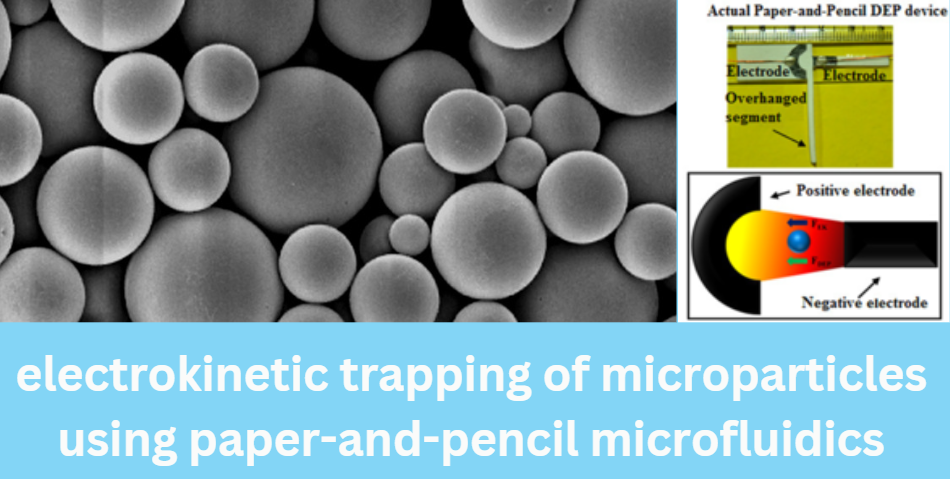Contents
- 1 Introduction to Electrokinetic Trapping and Microfluidics
- 2 What Is Electrokinetic Trapping?
- 3 The Concept of Paper-and-Pencil Microfluidics
- 4 Practical Applications of Electrokinetic Trapping Using Paper-and-Pencil Microfluidics
- 5 Advantages of Electrokinetic Trapping Using Paper-and-Pencil Microfluidics
- 6 Challenges and Limitations of Paper-and-Pencil Microfluidics
- 7 Future Directions for Electrokinetic Trapping Using Paper-and-Pencil Microfluidics
- 8 Frequently Asked Questions (FAQs)
- 8.1 Q1: What are the benefits of using paper-and-pencil microfluidics over traditional microfluidic systems?
- 8.2 Q2: How does electrokinetic trapping work in paper-and-pencil microfluidics?
- 8.3 Q3: What are the challenges of using paper-based microfluidics for particle trapping?
- 8.4 Q4: Can paper-and-pencil microfluidics be used for real-world applications?
- 8.5 Q5: What advancements can we expect in the future for electrokinetic trapping using paper-based systems?
- 9 Conclusion
Introduction to Electrokinetic Trapping and Microfluidics
In the world of microfluidics, researchers are continually innovating simpler, cost-effective techniques for manipulating particles on a microscale. One such advancement is the electrokinetic trapping of microparticles using paper-and-pencil microfluidics, an approach that leverages everyday materials for scientific applications. This concept offers exciting new possibilities, especially for applications in biosensing, diagnostics, and portable lab-on-a-chip devices. It combines the low-cost benefits of paper-based devices with the precision of electrokinetic manipulation, making it a transformative innovation for fields requiring small-scale particle manipulation.
In this comprehensive article, we will explore the key concepts, principles, and practical implications behind electrokinetic trapping of microparticles using paper-and-pencil microfluidics, along with insights into its benefits, challenges, and future potential.
What Is Electrokinetic Trapping?
Electrokinetic trapping refers to the technique of manipulating and holding particles in place using electric fields. Microparticles, such as cells, proteins, or other biological entities, are trapped and moved by the forces generated through an applied electric field. This technique is widely used in areas like biomedical diagnostics, chemical analysis, and environmental monitoring.
In traditional microfluidics systems, this is typically achieved using expensive, lab-grade equipment. However, the rise of paper-based microfluidics has opened the door to a more accessible and low-cost alternative for trapping microparticles.
Basics of Electrokinetic Trapping
The principle behind electrokinetic trapping involves a balance of forces acting on a particle:
- Dielectrophoresis (DEP): When a non-uniform electric field is applied to a particle, forces arise due to polarization, which can either attract or repel the particle.
- Electrophoresis (EP): In a uniform electric field, charged particles migrate towards the oppositely charged electrode. This migration is based on the charge of the particles and the strength of the electric field.
- Electro-osmosis: This is the movement of the fluid itself under an electric field, which can cause particles to move within the flow.
By carefully controlling the intensity and orientation of the electric field, microparticles can be trapped in place, where they can be studied, analyzed, or even manipulated for further experimentation.
The Concept of Paper-and-Pencil Microfluidics
Paper-based microfluidics is an exciting new area within microfluidics that employs paper as a substrate for fluid transport and reactions. Unlike traditional microfluidic devices, which require expensive photolithography or microfabrication techniques, paper-based systems offer a cost-effective and easy-to-manufacture alternative.
The key innovation here is the use of pencil-drawn electrodes on paper to create the necessary electric fields for trapping particles. These electrodes are typically made from graphite-based pencils and can be easily drawn on a paper surface, making the fabrication process simple, quick, and affordable.
How Does It Work?
To perform electrokinetic trapping of microparticles using paper-and-pencil microfluidics, a small paper channel is created, and pencil-drawn electrodes are placed at either end of the channel. By applying a voltage across the electrodes, an electric field is generated within the channel. When microparticles are introduced into the paper microfluidic system, the electric field can be used to trap or move them within the paper-based channel.
The novelty lies in the combination of paper and pencil as low-cost, disposable materials with electrokinetic principles that traditionally required more complex and expensive tools.
Practical Applications of Electrokinetic Trapping Using Paper-and-Pencil Microfluidics
The development of electrokinetic trapping of microparticles using paper-and-pencil microfluidics opens a new frontier for several fields, particularly in areas requiring low-cost, portable, and flexible devices. Here are some major applications:
1. Point-of-Care Diagnostics
Paper-based microfluidics combined with electrokinetic trapping could revolutionize point-of-care diagnostics. In resource-limited settings where access to advanced diagnostic tools is scarce, a paper-based system could trap and analyze biological samples such as blood or urine, offering an affordable and easy-to-use diagnostic solution.
2. Environmental Monitoring
With growing environmental concerns, real-time monitoring of contaminants in water, soil, and air is critical. A portable, low-cost system like paper-and-pencil microfluidics can be deployed in the field to trap and identify environmental pollutants such as heavy metals, toxins, or microorganisms.
3. Biochemical Analysis
Electrokinetic trapping allows for the precise control of biomolecules, enabling researchers to conduct biochemical assays on a small scale. This could aid in DNA sequencing, protein analysis, and other biochemical experiments where control of particle movement is crucial.
4. Educational Tools
The simplicity of the paper-and-pencil microfluidics design makes it an excellent tool for educational purposes. It can be used in high school or college-level labs to teach students about microfluidics, electrokinetics, and basic principles of physics and chemistry. Because the materials are affordable, it lowers the barrier for conducting advanced scientific experiments in educational settings.
Advantages of Electrokinetic Trapping Using Paper-and-Pencil Microfluidics
This technique offers several unique advantages over traditional methods:
1. Low Cost
The most obvious benefit of this system is its low cost. Unlike conventional microfluidic systems that require expensive fabrication tools, paper-and-pencil microfluidics can be produced using everyday materials. This makes it accessible to a wide range of users, from researchers in underfunded labs to students.
2. Easy Fabrication
The ability to create microfluidic channels and electrodes with a simple pencil and piece of paper is a significant advantage. No specialized equipment or clean rooms are required, reducing the complexity and time involved in device fabrication.
3. Portability
Since paper-based devices are lightweight and compact, they are ideal for applications requiring portability, such as point-of-care diagnostics and environmental monitoring in remote locations.
4. Flexibility and Scalability
Paper-based systems can be easily customized and scaled according to the needs of the experiment. Users can draw different electrode patterns or use various paper substrates to modify the device to suit their specific applications.
5. Eco-Friendly
Being made of biodegradable materials like paper, this system offers an environmentally friendly alternative to traditional microfluidic devices, which are typically made from plastics or other non-biodegradable materials.
Challenges and Limitations of Paper-and-Pencil Microfluidics
While the electrokinetic trapping of microparticles using paper-and-pencil microfluidics presents many advantages, there are some challenges and limitations that researchers need to consider:
1. Limited Durability
Paper-based microfluidics may not be as durable or long-lasting as their plastic or glass counterparts. The paper can degrade over time or when exposed to harsh chemicals, limiting its use in some long-term applications.
2. Precision and Control
While pencil-drawn electrodes are effective for generating electric fields, the precision and consistency of the electric field may be lower compared to more advanced fabrication methods. This could affect the reliability and accuracy of the microparticle trapping process.
3. Conductivity Issues
The use of pencil graphite as an electrode material introduces some challenges in terms of conductivity. The resistance of the pencil-drawn electrodes may fluctuate based on the pressure applied during drawing or the type of pencil used, which can impact the performance of the device.
4. Fluid Control
Controlling the fluid flow within the paper channels can be more challenging than in traditional microfluidic systems. Since paper is porous, the fluid may spread unevenly, which could impact the trapping and manipulation of microparticles.
5. Limited Integration with Other Technologies
Paper-based microfluidic systems are still in their infancy, which means that their integration with other advanced technologies, such as sensors or automation systems, may be limited at this stage.
Future Directions for Electrokinetic Trapping Using Paper-and-Pencil Microfluidics
The field of electrokinetic trapping of microparticles using paper-and-pencil microfluidics is still evolving, with exciting future possibilities:
1. Integration with Sensors
Future advancements may include the integration of low-cost sensors into the paper-based systems to enable real-time data collection and analysis. For example, integrating colorimetric sensors could provide visual feedback on particle trapping, making the system even more user-friendly.
2. Advanced Electrode Materials
Researchers are exploring alternatives to pencil-drawn electrodes, such as using conductive inks or advanced carbon-based materials. These innovations could improve the conductivity and reliability of the electric fields, enhancing the performance of electrokinetic trapping.
3. Broader Applications
As the field continues to advance, the application of paper-and-pencil microfluidics could extend to areas such as tissue engineering, pharmaceuticals, and personalized medicine. By offering an affordable and portable platform for microparticle manipulation, this technique could find widespread use in both research and industry.
4. Combining with Digital Technologies
The use of digital patterning methods could make it easier to create highly precise and consistent paper-based microfluidic devices. By combining digital fabrication techniques with the simplicity of paper-and-pencil designs, researchers could unlock new possibilities in precision electrokinetic trapping.
Frequently Asked Questions (FAQs)
Q1: What are the benefits of using paper-and-pencil microfluidics over traditional microfluidic systems?
The primary benefits of paper-and-pencil microfluidics include its low cost, ease of fabrication, portability, and flexibility. This technique eliminates the need for expensive equipment and materials, making it accessible for a broader range of users.
Q2: How does electrokinetic trapping work in paper-and-pencil microfluidics?
Electrokinetic trapping in this system works by applying an electric field across pencil-drawn electrodes on paper. The electric field manipulates microparticles through forces like dielectrophoresis and electrophoresis, allowing for precise trapping and movement within the microfluidic channel.
Q3: What are the challenges of using paper-based microfluidics for particle trapping?
Some challenges include the durability of paper-based devices, the precision of pencil-drawn electrodes, fluid control in porous paper channels, and potential conductivity issues with the electrodes.
Q4: Can paper-and-pencil microfluidics be used for real-world applications?
Yes! Paper-and-pencil microfluidics has significant potential in point-of-care diagnostics, environmental monitoring, biochemical analysis, and even educational settings. Its low cost and portability make it ideal for use in resource-limited environments.
Q5: What advancements can we expect in the future for electrokinetic trapping using paper-based systems?
Future advancements may include better integration with sensors, improved electrode materials, and wider applications in fields such as tissue engineering, pharmaceuticals, and personalized medicine.
Conclusion
The electrokinetic trapping of microparticles using paper-and-pencil microfluidics is an exciting innovation that holds the potential to transform multiple fields. This low-cost, accessible, and environmentally friendly method of microparticle manipulation provides a versatile platform for a wide range of applications, from diagnostics to environmental monitoring. While there are some challenges, the future looks promising, with many researchers continuing to explore ways to refine and expand this revolutionary technique.



